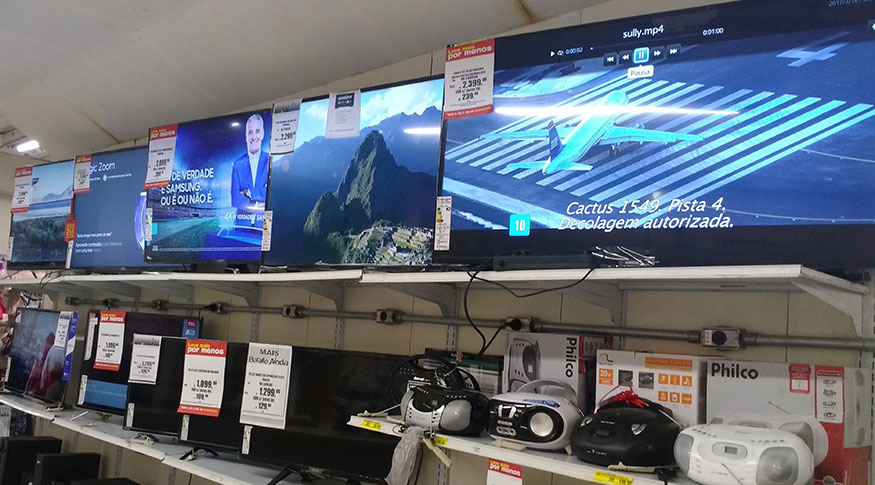Monthly Survey of Trade
Retail sales up 5.2% in July as trade remains in recovery mode
September 10, 2020 09h00 AM | Last Updated: September 11, 2020 02h10 AM

The volume of sales increased 5.2% in July, against the previous month, after a record hike of 13.3% in May and 8.5% in June. That is the highest result for a month of July since the start of the time series, in 2000, and the third straight increase in the year, with some categories recording results above those prior to the Covid-19 pandemic, such as Furniture and household appliances and Hyper and supermarkets. Data comes from the Monthly Survey of Trade, released today (10) by the IBGE.
Retail trade is 5.3% above the February rate, with almost the same change as from June to July (5.2%), that is, the increase recorded in June was somewhat significant. "Up to June, there had been some counterbalancing of what took place during the pandemic, so in July there is exceeding increase already," says the survey manager, Cristiano Santos.
The result of 5.2% from June to July also places retail trade at record levels, as in October 2014. "The lowest figure in comparison with that record position was -22.8%, in April 2020. In May, the difference fell to -12.5%, back at the level recorded during the 2016 crisis and, in June, retail trade was -5%. Now, in July, we've reached -0.1%, which is practically the record level of the series," says the survey manager.
He explains that in the month-om-month indicator, the change has fallen because the base has been very low. In April there was a record decrease of 11.7%; in May there was the biggest decrease of all times (13.3%), in June the rate was 8.5%, and now, 5.2%.
"Since the indicator fell from February to April, the base was very low and recovery has brought all indicators back to pre-pandemic levels. Some sectors are way above February figures, such as furniture and household appliances (16.9% above), hyper and supermarkets (8.9%) and pharmaceuticals (7.3%), besides construction material (13.9%), in extended retail," says Santos, as he highlights that the real gain against February did not reach all the categories, some of which have recorded low figures, for example wearing apparel and footwear (-32.7%), books, newspapers, magazines and stationery (-27.2%) and vehicles (-19.7%), in extended retail.
Only supermarkets recorded no sales increase in July
In July 2020, only the activity of hyper and supermarkets, food products, beverages and tobacco recorded no increase, remaining unchanged against the June figure (0.0). In the other sectors, positive rates prevailed, and reached seven of the eight activities surveyed. Books, newspapers, magazines and stationery recorded the biggest decrease (26.1%), followed by fabric, wearing apparel and footwear (25.2%), office, computer and communication material and equipment (11.4%), pharmaceutical, medical and orthopedic articles, toiletries and cosmetics (7.1%), fuels and lubricants (6.2%), other personal and domestic objects (5.0%) and furniture and household appliances (4.5%).
Against July 2019, retail trade increased 5.5% in July 2020, the second consecutive positive rate and kept its balance between positive and negative rates: four activities recorded increase, in terms of volume, whereas other four registered negative changes.
Among the activities recording increase, in the annual comparison, the main hike was that of furniture and household appliances(26.4%), followed by pharmaceutical, medical and orthopedic articles, toiletries and cosmetics (13.4%), hypermarkets, supermarkets, food products, beverages and tobacco (9.9%) and other personal and domestic articles (9.0%).
On the other hand, fabric, wearing apparel and footwear (-31.4%), books, newspapers, magazines and stationery (-25.1%), fuels and lubricants (-10.8%) and office, computer and communication material and equipment (-5.5%) were the sectors which recorded decreases. As a result, retail registered a decrease of 1.8% in the first seven months of 2020, against a change of -3.1% from January to June. In the cumulative index in 12 months, there was stability in sales, with a change from 0.1% in June to 0.2% in July.
Extended retail grows 7.2% against June and 1.6% in the annual comparison
Extended retail trade, which encompasses, besides trade, the activities of vehicles, motorcycles, parts and pieces and construction material, recorded an increase of 7.2% against June 2020, in the seasonally adjusted series, after a hike of 11.1% in the previous month. In this same comparison, the sector of vehicles, motorcycles, parts and pieces increased.13.2%, whereas construction material advanced 6.7%, both, respectively, after changes of 27.9% and 14.5% in the previous month.
Against July 2019, extended retail trade increased by 1.6%, interrupting a series of four months of decrease. Regarding the activities of extended retail, there was a decrease in vehicles and motorcycles, parts and pieces (-16.2%) and an increase in construction material (22.7%). From January to July, extended retail fell by.6.2%, versus -7.6% of the indicator registered up to June 2020. The cumulative indicator in 12 months, with a change from -1.4% up to June to -1.9% up to July, had a higher pace of decrease.
Retail records increase in 21 of the 27 Federation Units
From June to July 2020, in the seasonally adjusted series, the 5.2% increase in the national average of sales was due to a predominance of positive results in 21 of the 27 Federation Units, the main highlights being: Amapá (34.0%), Paraíba (19.6%) and Pernambuco (18.9%). On the other hand, as a negative contribution, there are six Federation Units, among which stand out: Tocantins (-5.6%), followed by Paraná and Mato Grosso (both with -1.6%).
In extended retail trade, the change of 7.2% between June and July 2020 was due to a predominance of positive results in 25 of the 27 Federation Units, with a highlight to: Amapá (35.0%), Paraíba (21.0%) and Pernambuco (15.8%). With negative rates, there were two Federation Units: Mato Grosso do Sul (-0.7%) and Piauí (-0.1%).




















